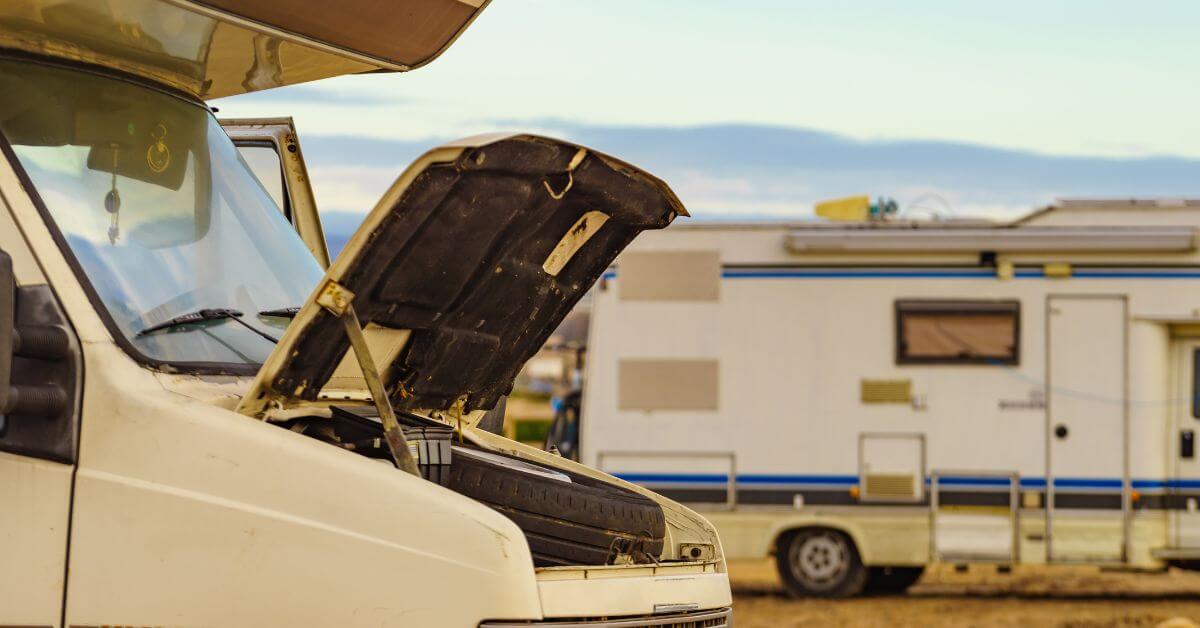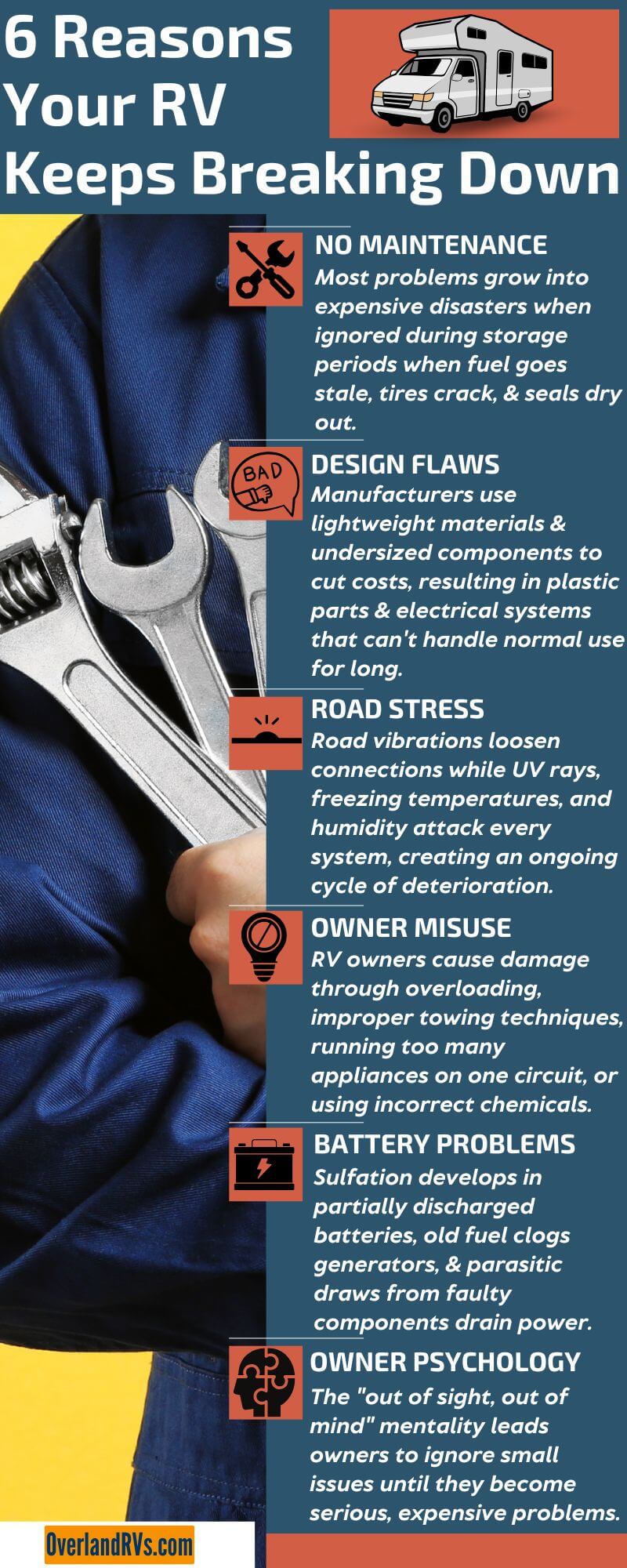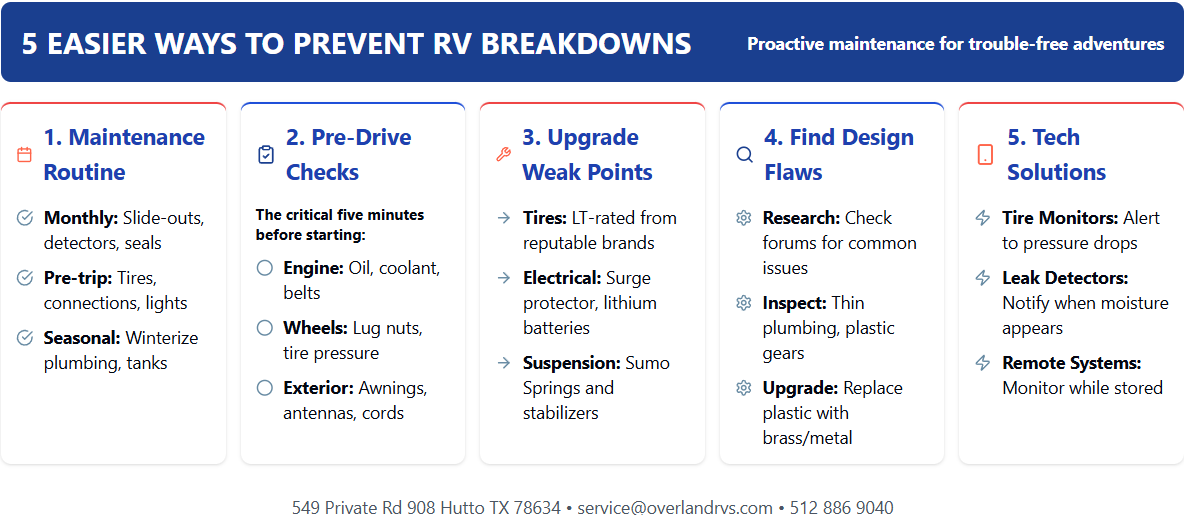
An RV can last up to 20 years easily. However, these 2 decades can be full of random breakdowns or a smooth ride, which totally depends on you. The purpose of this guide is to shift your focus from ‘oh god, not again’ to ‘ okay, what can I do to ensure it doesn't do that again’. Being one of the well-known service providers of RV repair Cedar Park TX, we have seen it all, from the minor common issues to the frequent major breakdowns.
So, we’re in a good position to guide you on what you can do to ensure you have an enjoyable experience RVing around the US without breaking down on a random road in an unfamiliar region at 11 o'clock midnight.
If you feel frustrated every time your RV breaks down during what should be a relaxing vacation, we get it. And you're not alone. Many RV owners face unexpected RV repairs that ruin their trips and drain their wallets. But here's the good news: understanding why these breakdowns happen can help you prevent them and save thousands in repair costs.

Most RV problems start small but grow into expensive nightmares when ignored. Your rig needs regular care, just like your car—but with more systems to check.
Skipping oil changes might seem harmless, but it's actually destroying your engine from the inside. Studies show about 60% of engine failures happen because of poor lubrication.
You face extra challenges if you only use your RV during summer months. Long storage periods create unique problems:
When looking for professional help, it's worth finding specialists who understand these seasonal issues. Several RV repair shops in Cedar, TX, including Overland, specialize in addressing these common maintenance-related breakdowns.
Not all RVs are built equal. Manufacturers often cut corners to keep prices down, and these shortcuts eventually lead to problems.
Many modern RVs use lightweight materials to improve fuel economy, but this comes at a cost. Plastic parts break under stress, thin walls crack, and undersized electrical systems can't handle the load of multiple appliances.
Take slide-out motors as an example. These powerful features work great when new but often burn out after a few years of regular use. Why? The motors installed at the factory barely meet minimum requirements, with no extra capacity for real-world conditions.
RV Component | Budget Brand Approach | Premium Brand Approach |
Cabinet Construction | Staples and glue | Screws and reinforcement |
Plumbing Fittings | Plastic | Brass or composite |
Electrical System | 30 amp service, minimal wire gauge | 50 amp service, heavy-duty wiring |
Wall Construction | Thin laminate, minimal insulation | Thick panels, quality insulation |
Your RV takes a beating, and no house ever does. Every mile you drive exposes it to shaking, rattling, and bumping, which loosens connections and wears out parts.
Road vibrations attack every system. Screws back out of cabinets. Plumbing connections loosen and leak. Appliance mounts weaken. What starts as a small rattle can turn into a major repair.
Nature also wages war on your rig. The sun's UV rays break down rubber seals and plastic components. Freezing temperatures crack pipes. Humidity promotes mold and rot, especially if it's over 60%, as per the EPA. Even parking near the ocean exposes your RV to corrosive salt air.
These forces work together against you. A loose screw from vibration lets water enter during rain, which leads to rot, which causes more movement, which loosens more screws. It's a vicious cycle.
Sometimes we cause our problems without realizing it. Even experienced RVers make mistakes that damage their rigs.
Overloading tanks, axles, and storage compartments stresses every system. Your RV has weight limits for a reason, but they're easy to exceed with extra gear, water, and supplies.
Improper towing seriously damages trailers and fifth wheels. One common example is a bent axle caused by driving with uneven tire pressure. This happens fast and costs thousands to fix.
You might also be damaging systems through honest mistakes:
Battery sulfation occurs when batteries sit partially discharged for long periods. Those white crystals that form on the plates aren't just ugly—they permanently reduce capacity. Many owners replace batteries yearly because they don't maintain them properly.
Generators suffer when they sit with old fuel inside. The gasoline or diesel breaks down, forming oxidative gummy deposits that clog carburetors and injectors. Then, when you need power the most, your generator sputters and dies.
Parasitic draws—small electrical leaks—drain batteries even when everything seems off. A single faulty switch, light, or appliance can flatten your batteries in days. This leads to a domino effect where other electrical components get damaged from low voltage.
"Out of sight, out of mind" explains why so many RV problems grow from small to serious. You don't notice the tiny roof crack during sunny weather. You forget about that "check later" plumbing drip. You ignore strange noises, hoping they'll fix themselves.
Many new RV owners assume everything works perfectly because the rig is new. They skip inspections, ignore RV maintenance schedules, and miss early warning signs. By the time obvious problems appear, the damage is extensive and expensive.
The truth is, RVs need more care than houses or cars because they combine the systems of both while being designed for mobility. Prevention costs pennies compared to repairs.
You've probably noticed these breakdowns always happen at the worst possible time—during vacations, far from home, or when shops are closed. The frustration builds as repair costs mount. But here's the truth: most RV failures are totally preventable with simple, regular care.

Monthly checks catch small issues before they grow. Mark your calendar to lubricate slide-outs, test smoke detectors, and clean roof seals. Set phone reminders for these tasks so they don't slip your mind.
Pre-trip inspections are crucial for peace of mind. A few days before hitting the road, check these critical systems:
Besides these, pay attention to seasonal maintenance, which prevents weather-related disasters. Before winter storage, winterize all plumbing, clean holding tanks thoroughly, and inspect every inch of your roof seals.
The five minutes before you start your engine are critical. These quick checks prevent most roadside emergencies.
Use this simple checklist every single time you prepare to drive:
System | What to Check | Why It Matters |
Engine | Oil, coolant, belts | Prevents overheating and stranding |
Wheels | Lug nut torque, tire inflation | Avoids blowouts and wheel separation |
Exterior | Awnings retracted, antennas down | Prevents costly wind damage |
Connections | Power cord, water hose disconnected | Stops "drive-away damage" |
Interior | Loose items secured, slides in | Prevents shifting cargo and damage |
The most dangerous issues often show warning signs right before departure. Listen for unusual sounds from the engine. Feel for soft brake pedals. Trust your gut when something seems off.
Some RV components are known time bombs. Replace them before they fail and ruin your trip.
Factory tires rarely last. They're often made cheaply with poor materials. Upgrade to LT-rated (Light Truck) tires from reputable brands. Add a Tire Pressure Monitoring System (TPMS) to watch for problems while driving
Electrical systems need protection. RV park power can surge and fry your circuits. A quality surge protector costs under $300 but saves thousands in potential damage. Consider lithium batteries to replace old lead-acid ones – they last longer and charge faster.
Suspension upgrades dramatically improve reliability. Products like Sumo Springs reduce bounce and stress on components. In areas exposed to moisture, replace standard wiring with marine-grade versions.
These upgrades pay for themselves through:
Online forums such as IRV2 or RV Forum can reveal common issues for your exact make and model. Spend an hour reading about what breaks other owners need. This research helps you know where to focus your attention.
Inspect stress points regularly. Look for thin plumbing that flexes too much. Check for plastic gears in slide mechanisms. Examine exhaust manifolds for cracks developing at welds.
Upgrade materials before they fail. Replace plastic water fittings with brass ones. Reinforce cabinet mounting points. Install metal brackets where plastic ones flex.
Document all modifications you make. This record helps with warranty claims and shows future buyers the value you've added.
Bluetooth tire monitors like the TST 507 system alert you to dangerous pressure drops or overheating. Water leak detectors placed near plumbing connections alert your phone when moisture appears.
Remote monitoring systems monitor your RV while it is stored. They track battery levels, internal temperature, humidity, and even motion. You'll know immediately if something needs attention.
These technologies cost far less than a single major repair. They offer peace of mind and catch problems when they're small and cheap to fix.
RV breakdowns leave you stuck. Missing tools turn minor issues into disasters. Pack these essentials to handle 90% of roadside emergencies.
Category | Tools/Supplies |
Tire & Wheel | Heavy-duty hydraulic jack (RV-rated), Lug wrench/breaker bar, Wheel chocks, Digital tire pressure gauge, 12V air compressor, Full-size spare/tire patch kit |
Battery & Engine | Heavy-duty jumper cables/jump starter, Assorted spare fuses, Basic fluids (oil, coolant, brake fluid), Fuel stabilizer/diesel treatment |
Basic Tools | Socket set (metric + SAE), Adjustable wrench, Pliers (needle-nose + slip-joint), Screwdrivers, Duct tape + utility knife, WD-40/penetrating oil |
Electrical & Lighting | Multimeter (12V/120V testing), RV surge protector, LED flashlight/headlamp + batteries |
Plumbing & Water | Water pump repair kit + spare seals, Teflon tape/pipe sealant, Sewer hose + disposable gloves, Plunger/drain snake |
Propane & Gas Safety | Propane leak detector, Gas shut-off wrench, ABC-rated fire extinguisher |
Emergency & Safety | Reflective triangles/flares, First-aid kit + emergency blanket |
Recovery & Towing | Tow straps (weight-rated), Traction mats, Collapsible shovel |
Diagnostics & Docs | OBD-II code reader, RV manuals (digital/physical), Roadside assistance membership details |
Miscellaneous | Zip ties + bungee cords, Work gloves + safety goggles, Emergency roof repair tape/tarp, Portable generator/solar charger |
Blowouts and flats are common. A regular car jack won’t lift an RV. Use a heavy-duty hydraulic jack rated for your rig’s weight. Check tire pressure monthly with a digital gauge. A portable air compressor fixes slow leaks. Always carry a full-size spare—patch kits fail in rain.
Dead batteries kill trips. Heavy-duty jumper cables or a jump starter revive them. Spare fuses stop electrical gremlins.
Keep fluids like coolant and oil sealed and upright. Fuel stabilizer prevents clogs in stored RVs. Diesel engines need treatment for algae in tanks.
Loose bolts cause leaks and rattles. A socket set handles most repairs. Adjustable wrenches tighten gas lines. Duct tape temporarily seals roof cracks. WD-40 quiets squeaky hinges. Needle-nose pliers pull debris from slide-outs.
Tool | Emergency Use |
Utility knife | Cuts frayed seatbelts or hose |
Slip-joint pliers | Fixes stuck valves |
Screwdrivers | Tightens loose outlets/switches |
Flickering lights mean trouble. A multimeter tests 12V fridges and 120V outlets. RV surge protectors stop campground power spikes. LED headlamps free your hands for night repairs. Spare batteries avoid darkness.
Leaks flood floors fast. A water pump repair kit replaces diaphragms. Teflon tape seals pipe threads. Sewer hoses need gloves and spares. Plungers unclog toilets when snakes can’t reach.
Propane leaks explode. Detectors sniff gas before you smell it. A shut-off wrench isolates leaks fast. ABC fire extinguishers tackle electrical, grease, and gas fires. Check expiry dates yearly.
Reflective triangles alert traffic. First-aid kits stop bleeding from sharp tools. Emergency blankets prevent hypothermia. Keep gear visible, not stuffed under seats.
Mud and sand trap RVs. Tow straps yank rigs free if rated for their weight. Traction mats grip slick surfaces. Collapsible shovels dig out tires. Never tow without chocking wheels first.
OBD-II readers decode engine lights. RV manuals explain fuse boxes and wiring. Roadside assistance info speeds up rescues. For complex issues, contact an RV repair Cedar Park TX specialist to avoid guesswork.
Zip ties secure loose wires. Bungee cords latch broken cabinets. Roof tape patches holes until professional fixes. Solar chargers keep phones alive. Gloves protect hands from hot engines or sharp edges.
Staring at a $3,000 repair bill might not be how you plan to end your vacation. RV breakdowns hit hard financially, often when you least expect them. The average RV owner spends thousands yearly on repairs they never budgeted for. But a better approach can save your wallet and your trips.
The 6% Rule keeps your RV running reliably. Set aside 6% of your RV's value each year specifically for maintenance and repairs. For a $50,000 motorhome, that's $3,000 annually or $250 monthly. This isn't optional—it's essential protection for your investment.
Beyond regular maintenance, you need an emergency fund. Keep between $2,000-$5,000 just for unexpected breakdowns. This covers those transmission failures or blown engines that happen in the middle of nowhere despite your best care.
Skipping maintenance to save money backfires badly. Preventative care cuts long-term repair costs significantly. That oil change you skipped can eventually turn into an engine rebuild. That roof inspection you postponed can create water damage throughout your rig.
Even with perfect maintenance, breakdowns happen. Smart RVers prepare for these moments long before they occur.
The roadside can be deadly. In January 2022, a severe snowstorm in Murree, Pakistan, led to over 157,000 vehicles being stranded. Tragically, at least 22 tourists died, primarily from hypothermia and possibly carbon monoxide poisoning, as their vehicles were immobilized by heavy snowfall. Your first priority during a breakdown is staying alive.
Always carry road flares or reflective cones. Place them 50, 100, and 150 feet behind your RV to warn approaching drivers. The bigger your rig, the more warning other drivers need.
If your breakdown location feels unsafe, call highway patrol immediately. They can provide traffic control while you wait for repairs. Some states have special RV breakdown assistance programs.
Never stay inside your RV if it's partly on the road. Find a secure location away from traffic. If you must exit your vehicle during night breakdowns, wear reflective clothing.
When you're stuck, the right roadside plan can make all the difference. However, not all plans properly cover RVs.
Compare coverage limits carefully. Many plans advertise "unlimited towing" but limit distances. Verify they cover your specific RV type and size. Some exclude fifth wheels or motorhomes over certain lengths.
Response time matters more than price. In extreme weather, you might wait 6+ hours with budget services. Premium plans average under 90 minutes nationwide.
Fellow RVers often provide better help than paid services. Join online communities before you need them.
Facebook groups like "RV Repairs and Tips" connect you with experienced owners who've faced similar breakdowns. Reddit's r/GoRVing community can provide advice during emergencies.
Create a map of trusted repair shops nationwide. Add shops recommended by other owners, not just chain locations. Many small, family-owned shops provide better service than big names.
Exchange contact info with other RVers you meet on the road. They can become your emergency support system, bringing parts or tools to remote locations when deliveries aren't possible.
Whether you’re a new RV owner or an experienced one, keeping your home on wheels in top shape is something you should never overlook because that can lead to breakdowns down the road, especially when you’re having a good time cruising around with family and friends.
To avoid that, you can visit Overland RVs for proactive maintenance and immediate RV repairs in Cedar Park, TX, and we’ll have a look.